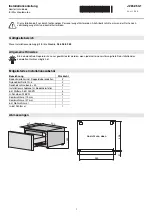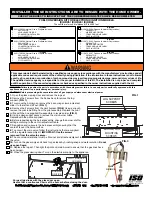
17
Pirani Vacuum Sensor System
Always use a probe gas in small quantities to aid in pinpointing the leak. In
general, leak test sensitivity is greater for lower system pressures.
3) The Pirani Sensor is sensitive to any leak probe gas lighter or heavier than
the gas in the system, however, for optimal sensitivity, select a probe gas
with the largest difference between its molecular weight and that of the
system gas.
A gas different than the system gas entering through a leak will change the
thermal energy transfer. Lighter gases increase thermal energy transfer while
heavier gases reduce it. Helium or argon gas are suitable to probe a system
pumping air or nitrogen. Slowly and methodically probe with a small amount of
gas. Flooding the leak with gas or moving the gas quickly past the leak can
confuse the search since system time lags may be significant.
4) The type of vacuum pump used can also affect the accuracy of the leak
test. For moderate size leaks, pump down the system with a high vacuum
pump such as a diffusion or turbo pump if possible (ion and cryo pumps are
not recommended). Leak testing can be done with a mechanical pump,
however, they may cause cyclical variations in pressure with rotation of the
vanes. This shows up as a large background noise signal possibly masking
the leak signal.
5) Placement of the Sensor and the pump relative to the leak can also be a
major factor in optimizing the sensitivity of the Series 917 Pirani System.
Place the pump away from the suspected leak source and place the Sensor
between the leak and the pump to reduce the Sensor response time to better
identify the leak location. Vacuum tubing between the suspected leak and the
Pirani Sensor should be as short and wide as possible to shorten the time
required for the probe gas to reach the tube.
If the above leak detection method fails to indicate the location of a leak,
unexpected high pressures may be caused by a virtual leak, i.e., outgassing
of a system component. You can locate outgassing parts, or “virtual leaks,”
as well as true gas leaks using the
rate-of-pressure-rise method.
With the Controller on, pump down the system to a base pressure, then
isolate the pump by closing a valve. The rise of the pressure over a time
interval is then measured. A very fast rise in pressure is indicative of a leak.
Repeat this procedure as often as necessary.
Содержание HPS 917
Страница 1: ...HPSTM Products Series 917 Pirani Vacuum Sensor System OPERATION AND MAINTENANCE MANUAL...
Страница 2: ......
Страница 6: ...Pirani Vacuum Sensor System...
Страница 29: ...23 Pirani Vacuum Sensor System Notes...
Страница 30: ...24 Pirani Vacuum Sensor System...
Страница 31: ......
Страница 32: ......










































